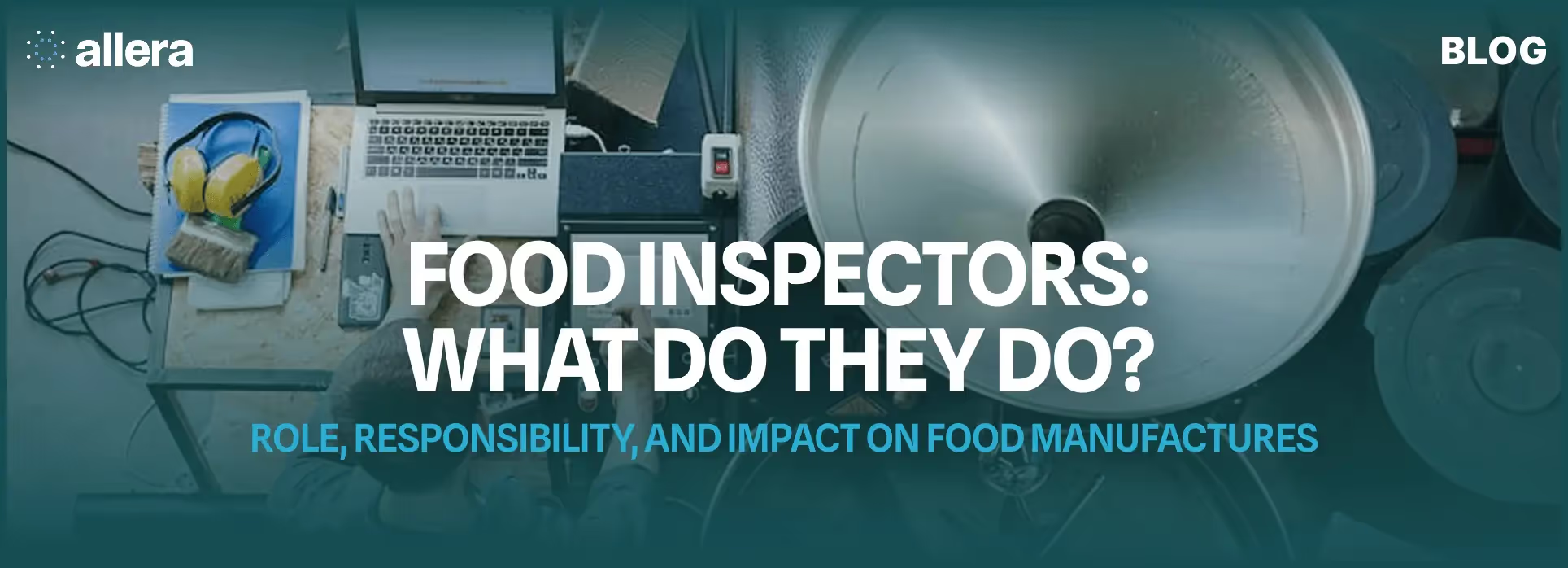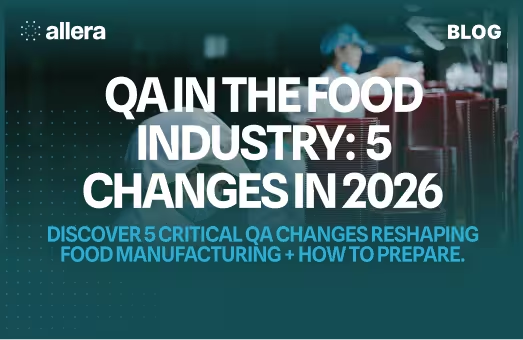

Food Inspectors: What Do They Do?

Key Takeaways
- Food inspectors protect public health by ensuring food facilities meet federal, state, and local standards.
- Three main inspection types—surveillance, compliance follow-up, and for-cause—address different risk levels and situations.
- Preparation is key: documentation, safe food handling, and regular safety testing.
- Common violations include cross-contamination, poor temperature control, and chemical storage issues.
- Becoming a food inspector requires education, training, and often hands-on experience.
Inspections don’t have to be stressful—when your records, training, and controls are in place, every visit becomes a quick confirmation that you’re doing things right.
Food Inspectors: What Do They Do?
Food safety is a fundamental requirement for running a successful food business. The U.S. Food and Drug Administration (FDA) notes that more than 3,000 state, local, and tribal agencies regulate over 1 million food establishments across the country (FDA). Inspectors—often called health inspectors, regulatory inspectors, or compliance officers—are trained to spot risks, enforce regulations, and protect public health.
Their presence can feel intimidating, but inspections are not meant to shut businesses down; they are designed to confirm your facility is operating safely and in compliance with the law. By understanding their role, you’ll be better prepared to meet expectations and keep your facility running smoothly.
What Does a Food Inspector Look for During Inspections?
When inspectors arrive, they’re evaluating whether your facility meets federal, state, or local codes. Common areas of focus include:
- Sanitation: Cleanliness of floors, equipment, food-contact surfaces, and waste disposal.
- Food-handling practices: Temperature control, hygiene, and cross-contamination prevention.
- Documentation: Logs, SOPs, hazard analyses, and training records.
For example, inspectors may check whether your cold storage units hold food below 41°F, or if cleaning records confirm that sanitizing procedures were followed consistently. They may also request to see your Hazard Analysis and Critical Control Points (HACCP) plan or Food Safety Plan, especially if you’re operating under FDA’s Preventive Controls rule in 21 CFR Part 117.
Inspections are not limited to what’s visible on the surface. They often include a review of written procedures, staff knowledge, and verification that you’re actively monitoring food safety risks.
Qualifications and Training of Food Inspectors
Food inspectors are highly trained professionals. Many inspectors hold a degree in food science, public health, or a related field, while others qualify through specialized training and experience. They undergo extensive regulatory training and often come with hands-on industry experience.
At the federal level, the USDA’s Food Safety and Inspection Service (FSIS) employs more than 6,500 inspectors nationwide to oversee meat, poultry, and egg production (FSIS Careers). State and county health departments hire inspectors to monitor restaurants, grocery stores, and food processors.
This training ensures that inspectors know how to evaluate not just facilities, but also the systems companies use to manage food safety.
Types of Food Safety Inspections
Not every inspection is the same. The FDA and state agencies generally classify them into three categories:
- Surveillance Inspections: Routine or targeted visits, often scheduled annually or more frequently for higher-risk facilities. A plant processing raw poultry, for instance, may be inspected three or four times per year.
- Compliance Follow-Ups: Conducted after violations or failed inspections. These visits verify corrective actions and can help restore trust if problems were identified previously.
- For-Cause Checks: Triggered by foodborne illness outbreaks, consumer complaints, or recalls. These are high-pressure inspections where investigators seek to identify root causes and evaluate whether corrective actions are effective.
Knowing which type of inspection you’re undergoing can help you prepare appropriately.
How to Prepare Your Facility for Inspector Visits
Preparation is the most effective way to ensure inspections go smoothly. Here are three key steps:
Step 1: Maintain Proper Documentation
Inspectors almost always review records—temperature logs, cleaning schedules, training records, and hazard analyses. Many companies still rely on binders and spreadsheets, but these can be time-consuming to manage and difficult to keep consistent.
Example: Some facilities track cooler temperatures on paper logs. That works fine until an inspector asks for last month’s records and a page is missing. By contrast, digital systems centralize logs and create automatic timestamps, reducing the chance of missing data.
Different software companies approach documentation differently, but digital systems are the best way to stay consistent. With tools like Allera’s Document Control software, facilities can centralize SOPs, revisions, and corrective action records in one place. AI checks help ensure documents align with regulatory requirements, so when an inspector asks for a record, it’s instantly available.
Step 2: Monitor Food Handling
Inspectors are trained to look for practices that prevent contamination and protect consumers. This includes:
- Proper handwashing techniques at designated sinks.
- Strict time and temperature controls, especially for raw proteins.
- Separation of allergens from other ingredients.
- Cleaning and sanitizing between food-contact surfaces.
These practices may sound simple, but even small slip-ups can cause violations.
One way facilities make this easier is by using checklists at each workstation. Instead of relying on memory, employees follow a clear list of daily tasks. Companies often embed these checklists digitally and require employees to complete them in real time. The benefit goes both ways: workers stay consistent, and management gets a verified record that can be shown during inspections.
Step 3: Conduct Regular Food Safety Testing
Routine food safety testing verifies that sanitation programs are effective and that food products remain safe. This might include microbiological swabs of food-contact surfaces, product testing for pathogens, or allergen verification tests.
Regular testing demonstrates to inspectors that you take a proactive approach. Many labs now return results quickly, which allows time to correct issues before an inspection.
The critical part is documentation—linking test results back to your hazard analysis and corrective actions so inspectors can see the full picture.
Most Common Violations
Despite preparation, certain violations occur frequently:
- Cross-contamination risks – Raw meat touching ready-to-eat produce, allergen mismanagement, or storing chemicals near food.
- Temperature control issues – Foods held in the danger zone—typically between 40°F and 140°F (with regulatory cutoffs at 41°F and 135°F)—can quickly become unsafe.
- Chemical storage errors – Inadequate labeling or unsafe proximity to food products.
Training employees to recognize and prevent these risks is essential. Some companies also use digital traceability systems to log every step, ensuring that corrective actions are visible and auditable.
Critical Control Points (CCPs) and Inspections
During inspections, regulators often review Critical Control Points (CCPs)—the steps in your process where control is essential to prevent or eliminate a food safety hazard. CCPs are the backbone of a HACCP (Hazard Analysis and Critical Control Point) system and directly influence inspection outcomes.
Inspectors may ask questions like:
- How were your CCPs identified?
- What are your critical limits (e.g., temperature, pH, time)?
- How do you monitor and verify them?
Examples of CCPs inspectors focus on:
- Cooking – Ensuring internal temperatures reach pathogen-killing levels.
- Cooling – Preventing bacterial growth in prepared foods.
- Metal detection – Verifying no foreign objects enter packaging.
- Chemical control – Ensuring sanitizers and residues remain within safe limits.
Facilities that document CCP monitoring—along with corrective actions when limits are exceeded—demonstrate strong control over food safety risks. Inspectors see this as a sign of maturity in your HACCP system and overall compliance readiness.
Becoming a Food Inspector
For those interested in the career path, entry-level requirements typically include:
- A bachelor’s degree in biology, food science, or a related field.
- Some hands-on food industry experience.
- Passing a qualifying test, followed by on-the-job training.
At FSIS, inspectors monitor slaughter plants, examine animals before and after processing, collect samples, and verify sanitation. The job is physically demanding—requiring repetitive movements, standing in cold environments, and frequent inspections of equipment. For others, more policy-focused roles are available in regulatory offices or laboratory analysis.
Conclusion
Food inspectors play a vital role in protecting consumers and ensuring the integrity of the food supply. For businesses, inspections are opportunities to prove systems are working—not roadblocks to operations.
Staying audit-ready comes down to three things: reliable documentation, strong training, and proactive verification. Companies that embed these into their daily routines rarely scramble when inspectors arrive.
Real-world example: Eden Green streamlined compliance by centralizing records with digital documentation tools. By doing so, they passed audits with confidence and saved hours that would otherwise be lost chasing paperwork.
If your team wants the same peace of mind, explore how digital documentation tools can keep your facility inspection-ready year-round. Visit Allera’s home page for resources and case studies designed to help food businesses prepare with confidence.
By taking a proactive approach, you’ll not only reduce inspection stress but also build long-term trust with regulators and customers alike.
FAQs
What is the minimum salary of FDA inspectors?
Entry-level FDA consumer safety officers and inspectors typically start around $40,000–$50,000 annually, though pay depends on grade level, location, and government pay scales.
What is the highest salary of a food inspector?
Senior-level federal food inspectors, such as those in the USDA’s Food Safety and Inspection Service (FSIS), can earn over $90,000–$100,000 per year, depending on location and years of service. Some supervisory or specialized roles may exceed that range.
How much does FDA approval cost for food products?
Costs vary widely. Registering a facility itself is free, but compliance expenses add up—testing, audits, consultants, and possible user fees. For example, reinspection fees can run thousands of dollars per day. For specialized approvals (like food additives), costs can reach hundreds of thousands in research and regulatory submission expenses.
Who needs an FDA license?
Any facility that manufactures, processes, packs, or stores food for U.S. distribution must register with the FDA. This includes domestic and foreign companies. Certain high-risk products, such as infant formula or bottled water, may require additional oversight. If you’re producing food for retail or wholesale, you almost certainly need FDA registration.
How difficult is it to get FDA approval?
For food facilities, FDA “approval” usually means staying compliant and inspection-ready. The difficulty depends on the type of product—basic packaged foods may only require registration and good practices, while medical foods or additives require extensive safety data and testing. Strong documentation and a QMS make the process far smoother.
Does the FDA make money?
The FDA isn’t a profit-making agency—it’s funded by a mix of congressional appropriations and user fees from regulated industries. These fees support activities like facility inspections, product reviews, and food safety monitoring. While the FDA collects money, its role is regulatory, not commercial.
What are FDA user fees?
FDA user fees are charges companies pay to fund regulatory reviews and inspections. Under the Food Safety Modernization Act, facilities that require reinspections or importers participating in the Voluntary Qualified Importer Program (VQIP) must pay fees. These costs vary annually and can add up, so many companies adopt digital compliance systems to avoid costly reinspection triggers.
How long does it take to get an FDA license?
The timeline depends on the type of food facility and product. For most food facilities, FDA registration is immediate once you submit the required information online, but inspections or approvals tied to higher-risk products (like infant formula or dietary supplements) can extend the process to several months. Staying organized with records and compliance documentation helps reduce delays.
What does it mean to be FDA certified?
“FDA certified” usually means a facility, product, or system has met FDA regulatory requirements. For food companies, this doesn’t mean the FDA stamps every product—it means your facility is properly registered, compliant with the Food Safety Modernization Act (FSMA), and inspection-ready. Certification shows customers and regulators that your operation follows strict safety and quality standards.




.avif)

.avif)

.avif)
.avif)

